Abstract
As government documents, postage stamps are a rich source of information about a government’s policies on a wide range of subjects. In this article, a comparative semiotic analysis of the first seventy-five years of North and South Korean stamps is used to illustrate the similarities and differences in their attitudes towards ‘religion’ and religious practice. A corpus of stamps on a ‘religious’ theme was created for stamps issued by both governments from which a series of themes and motifs was noted. The semiotic analysis of the themes and motifs showed that while on South Korean stamps Buddhist motifs constituted the majority of stamps commemorating cultural history, there were few references to the commemoration of Buddhism itself. The reverse was found to be true for Christianity. Although Christianity was not shown to be a major expression of Korean culture, Christianity itself was commemorated extensively. On North Korean stamps, folklore and Christian motifs predominated as projections of cultural history, but the Christian motifs referred only to foreign cultures, not Korean culture. Motifs relating to the foundation myth of Tan’gun were common to both North and South Korea. However, in the South, motifs from the myth referred to the nation, while in the North they referred to the ruling family.
1. Introduction
What are the attitudes of governments in the northern and southern parts of the Korean Peninsula towards religion and its practice? There are many forms of documentary evidence the researcher can turn to, including formal government documents, diaries, letters, journalistic and media sources, and recorded interviews, among others. However, there is one often-overlooked source of information that visually presents a government’s views on religion and religious practice. This is the postage stamp, which is, in effect, a small government document. I propose to examine the themes and motifs on stamps issued by governments North and South from the establishment of the respective national governments in 1948 to 2023 using a semiotic analysis of their designs to reveal what messages are being conveyed through the design of the stamps.
I have argued elsewhere (Grayson 2023) that stamps are not simply pieces of paper indicating that the carriage charge for a letter or other postal item has been paid. I argued that the design of and images appearing on postage stamps are used by governments to project ideas and concepts to both domestic and international audiences about government policy and about the government’s views on national history, national ideals, goals, culture, and social affairs. The governments of the Democratic People’s Republic of Korea (North Korea) and the Republic of Korea (South Korea) have different and distinct attitudes towards religion (especially regarding the restrictions placed on religious practice), and one would expect to find this attitude reflected directly or indirectly in stamp design. But, precisely what themes or attitudes are revealed in stamp design, and how can one determine what they mean? In this article, I will analyse the stamps issued by both Korean governments from their establishment from 1948 to 2023, representing the first seventy-five years of postal issues since Liberation from Japanese rule. To analyse the designs of the stamps, I will use a method of analysis based upon the semiotic theory of Charles Sanders Peirce (1839–1914), as developed by more recent scholars. The classic works on the semiotic analysis of stamps as government documents are David Scott’s European Stamp Design: A Semiotic Approach to Designing Messages (Scott 1995) and Jack Child’s Miniature Messages: The Semiotics and Politics of Latin American Postage Stamps (Child 2008). More recent work on stamps as messengers is found in Stanley D. Brunn’s (ed.) Stamps, Nationalism and Political Transition (Brunn 2023).
2. Methodology and Sources
David Scott, in European Stamp Design (Scott 1995, pp. 6–8), following Peirce’s concept of the ‘sign’, states that there are three types of ‘sign’ that can be used in the analysis of stamp design—the index, the icon, and the symbol. The index indicates what the stamp is, i.e., that it is a postage stamp (it is not a tax revenue stamp), that it is from a specific country (South Korea), and that it has a particular purpose (air mail postage). The index is almost always textual, although some design elements may form part of the indexing feature. Thus, stamps issued by South Korea have a small yin/yang design followed by the Korean phrase Tae Han min’guk up’yo (대한민국우표, Republic of Korea Postage), followed by the English name ‘Korea’. The index on North Korean stamps displays the Korean phrase Chosŏn up’yo (조선우표, Chosŏn [Korea] postage), followed by the English wording ‘DPR Korea’.
The icon, however, is the key element of a stamp’s design, as it displays the subject or theme of a particular stamp or series of stamps. The icon is almost always pictorial, that is, it graphically displays an aspect of the issuing nation’s history, its culture, its government’s economic or political policies, or something about its national society, but it may also depict subjects or themes that do not have any direct connection with the issuing nation. In this article, we shall be examining the images (icons, in Peircean terms) depicted on Korean stamps North and South that show the different kinds of sub-themes that can be grouped together under the broad theme of ‘religion’.
The final element of a stamp’s design is the ‘symbol’, some pictorial element that has become representative of the nation. On British definitive stamps (standard issue stamps that do not commemorate any theme or subject), the icon is the monarch’s head, but this has become so representative of British stamps that it also acts as a national symbol. On Republic of Korea stamps, the yin/yang appearing in the index of South Korean stamps has become representative of the state and is therefore a symbol in Peircean terms. The index of North Korean stamps lacks a national symbol, although the icons of North Korean stamps have a variety of symbols that will be discussed below.
To create a corpus of stamps issued by North and South Korea for research analysis, I have used the digital catalogue of the StampWorld website, which is one of the most comprehensive and complete listing and description of stamps currently available (www.stampworld.com accessed on 30 April 2024).1 I have examined every item that has a catalogue number on this site for materials issued by both Korean governments. Between its inception in Autumn of 1948 and the end of December 2023, the Republic of Korea produced 3686 stamp issues, compared with the Democratic People’s Republic of Korea, which, over the same period, produced 7164 issues. To put these figures in a global context, at the same time, the United Kingdom produced 4572 issues, the United States 6476 issues, the Soviet Union and its successor, the Russian Federation, 8252 issues, and Japan 11,563 issues. Thus, amongst major industrial nations, South Korea has produced considerably fewer stamp issues than most countries, including the UK. North Korea, having produced nearly twice as many issues as South Korea, ranks among the higher issuers of new stamp types, although not the greatest number. It should be noted that the number of stamp issues is not to be confused with the overall volume of stamps printed. The number of different stamp issues produced over a period of time is one indication of the extent to which a government thinks it must promote or illustrate a certain concern or policy.
If ‘religion’ is the broad theme being examined in the icons or images of stamps, what is included in this definition? First of all, we will be looking for representations of or references to the major formal religious traditions of the world—Christianity, Buddhism, Islam, Judaism, etc. However, we also include references to ‘folk religion’, popular religious traditions, and their practice. Confucianism, as it is principally a philosophical tradition, will only be considered if there is a reference to rituals. References to myths and legends (but not folktales) will be included, as well references to the Sip changsaeng (十長生, Ten Symbols of Longevity) and the twelve symbolic animals associated with the East Asian lunar calendar cycle. Design motifs to be considered will be persons either historic, mythical, or generic, buildings (churches, temples, shrines, altars), practices (rituals, dances), ritual objects, including items used in the performance of rituals, texts (scriptures, ritual texts, historic books), and anything else that has a ‘religious’ reference. In North Korea, a very large number of stamps has been issued that promote the cult of the leader and his family. From that body of stamps, only those stamps that have a specifically ‘religious’ or ‘folkloric’ theme have been included in the North Korean corpus.
Two broad sub-topics will be considered—themes and motifs. By ‘theme’, I mean both the stated subject of a stamp’s design, i.e., Buddha’s Birthday, and an unstated or implicit subject. ‘Motif’ will mean those design elements that are used to convey a theme. In some cases, the connection of a motif with a theme may be explicit, but in other cases it will be implicit and not apparently related to the purported theme of the stamp.
3. Themes and Motifs
Initially, a corpus of North and South Korean stamps was created that have either a religious theme or that use religious imagery as part of the ‘icon’ element of the stamp.2 The index element has not been considered as we are interested in the use of the icon as a means to project a government’s policies. As it has been noted above, the index for South Korean stamps includes the yin/yang symbol, but the North Korean index does not contain a symbolic element. From the digital catalogue of stamps on the StampWorld website, every stamp issued for the first seventy-five years of the two republics was examined, and a corpus for each nation was created of every stamp with a religious theme or that contained religious motifs. Of the total number of stamps issued by the Republic of Korea until the end of 2023, 209 stamps were selected for closer examination. This represents 5.7 percent of the total number of stamp issues from the period. On the other hand, the corpus of relevant stamps from the Democratic People’s Republic of Korea consisted of only 139 stamp issues, or 1.9 percent of the total number they issued during the same period. This is interesting for two reasons. First, as a percentage of each corpus, South Korea issued three times as many relevant stamps than North Korea. Second, they also issued considerably more stamps with a religious theme or that contained religious motifs. This is particularly surprising because, as mentioned above, North Korea issued nearly twice as many stamps as South Korea during the past seventy-five years.
Stamps or minisheets3 issued by governments around the world are of two types, definitive stamps and commemorative stamps. Definitive stamps are the standard sets of stamps issued for normal usage and do not have any theme, although the icon has a subject. These stamps are also issued and re-issued over a long period of time (Mackay 2003, p. 42). Commemorative stamps, on the other hand, do have a theme and are one-off issues. They commemorate, promote, or highlight a particular theme or themes. A commemorative stamp may be part of a series that is issued for only one year or issued over several years (Mackay 2003, p. 31). Issuance of definitive and commemorative stamps forms an important distinction between South and North Korean stamp-issuing policies. The Republic of Korea issues both definitive stamps and commemorative stamps, whereas the Democratic People’s Republic of Korea only issues commemorative stamps. It is interesting to note which images appear on the icon of an ROK definitive stamp, which does not ‘commemorate’ anything but does carry a message in its icon. A comparison of ROK definitives with both ROK commemoratives and DPRK stamps is instructive.
From an examination of all 209 stamps issued by South Korea that have a religious theme or use religious motifs, there are three broad categories of images that can be discerned—‘cultural history’, ‘commemoration of an aspect of Christianity’, and ‘commemoration of an aspect of Buddhism’. In addition, there is a ‘miscellaneous’ category that has a potpourri of themes that use a variety of religious motifs to convey the theme.
3.1. Promotion of Culture and History
3.1.1. South Korea
Under the category of ‘cultural history’, design elements in the stamp’s icon include such motifs as temples, shrines, paintings, ceremonial objects, dancers, drummers, and other aspects of material culture or practised religion. Examination of these images showed that the objects or subjects portrayed were perceived to be either historic or ‘traditional’ and had been selected to show either the historic depth of national culture or its sophistication. For example, the highest-value stamp (KRW 100) in the first definitive series of ROK stamps issued in 1949 shows an image of the Tabo-t’ap (多寶塔) pagoda (SK 54, Figure 1), which is part of the Pulguk-sa (佛國寺) temple complex dating to the mid-eighth century. In this series, there are depictions of another historic but non-religious building and scenes of industry and agriculture. As a definitive stamp, SK 54 would have been seen much more frequently than any commemorative issue. This use of Buddhist cultural imagery on stamps has continued down into the present. On 22 February 2023, the ROK issued a set of three commemorative stamps depicting repatriated Buddhist objects—a temple bell (SK 3632), a Buddhist scriptural text (SK 3633), and a portable Buddhist shrine (SK 3634). These objects had all been taken as booty during the incursions of French troops in the 1870s (Kim 2012, pp. 281–83) and were being returned to Korea. On 14 April 2023, South Korea issued a set of four stamps depicting four different temples (SK 3668–3671). Overall, Buddhist images constituted 45 percent of all religious images on stamps in the cultural history category, amounting to 73 stamps in total. Of these 73 stamps, one-quarter of the issues were definitive stamps. The images on the definitive stamps would have been seen repeatedly, unlike images on individual commemorative stamps, which would have had a more limited circulation.
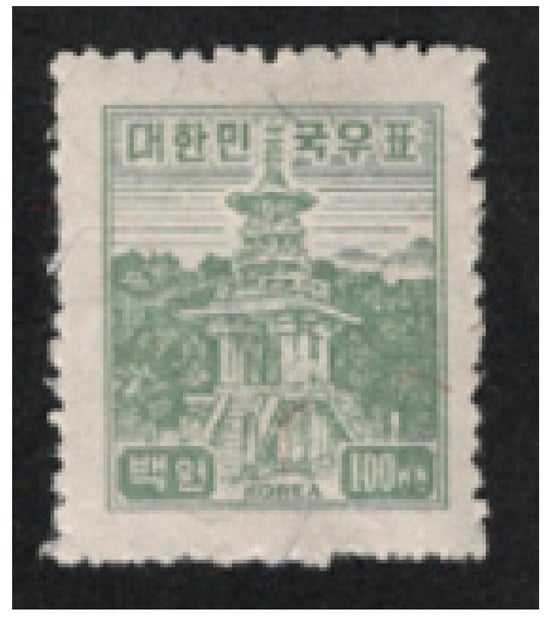
Figure 1.
Tabo-t’ap pagoda, Kyŏngju, definitive stamp, 1949.
The next largest category of images in the subject area of cultural history was the ‘religious‘ aspects of folklore, accounting for 66 images or 41 percent. Again the use of imagery of this type appears very early. On 1 April 1951, less than three years after the founding of the state and during the middle of the Korean War (1950–1953), South Korea issued a definitive series of stamps that included issues depicting two folkloric animals, the irwŏl-hak (日月鶴, Sun-Moon Crane) and the Paekho (白虎, White Tiger), SK 72 and SK 73 (Figure 2 and Figure 3). Subsequent issues had images depicting spirits on the ends of roof tiles, folkloric animals in paintings or adorning objects, such as poles, as well as performance images, such as shamanic dancers and shamanic ceremonies in modern art. A repeating folkloric image is of the Sip changsaeng (十長生, Ten Symbols of Longevity; Pratt and Rutt 1999, p. 273). Although these ten symbols are common to all of the nations of East Asia, the Korean tradition has been to place them all together within a single work of art, often as the scene on a multi-panel screen. In 1980, the ROK issued four stamps (SK 1213-1216, Figure 4) on this theme, which was repeated again in 1989 (SK 1585) for World Environment Day and again on 16 August 1994 in a set of eight stamps for the world stamp exhibition PhilaKorea 1994 (SK 1791–1797). The date of issue is significant, as August 15 is the date in 1945 when Japan surrendered to the Allied forces. The date is celebrated each year as national Liberation Day (Haebang-ŭi nal, 解放 의 날) and often has had a commemorative stamp issued on or around that date. The most recent issue on the Sip changsaeng motif was a minisheet from 30 March 2023 (SK 3639–3654).
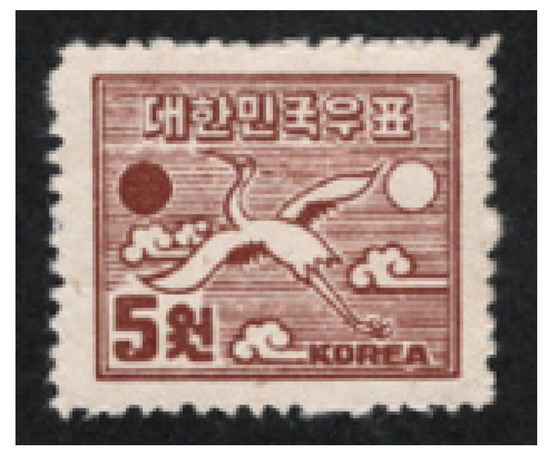
Figure 2.
Irwol-hak, definitive stamp, 1951.
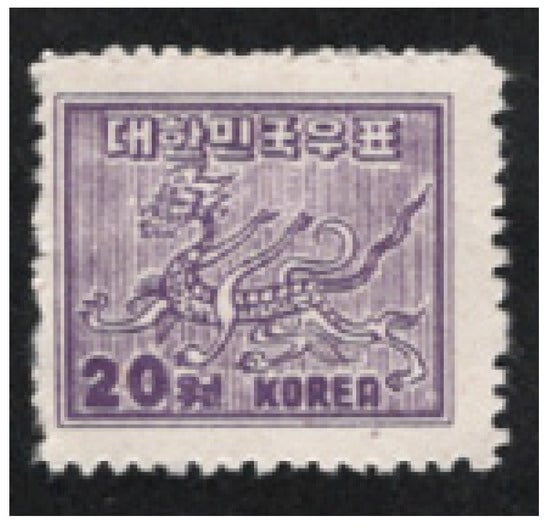
Figure 3.
Paek ho, definitive stamp, 1951.

Figure 4.
Sip Changsaeng, 1980.
One of the most significant types of folkloric material used in the promotion of cultural history has been the depiction of the foundation myths to illustrate the origins of the Korean people and the Korean state. One of the earliest references to the Myth of Tan’gun (檀君), the purported founder of the Korean nation and state, is a depiction of the Mani-san altar, which is claimed to be associated with the historic worship of the national founder, on a stamp from 28 September 1976 (SK 1054, Figure 5). This was for International Tourism Day. The explicit use of foundation myths as descriptions of national cultural history begins in the millennium. On 3 January 2000, the ROK issued a set of five stamps set in a minisheet, one of which (SK 2059) depicted the Mani-san altar and the Samguk yusa (三國遺事, Memorabilia of the Three Kingdoms), which contains the locus classicus for the text of the Myth of Tan’gun. Then, from 2008 to 2012, the ROK issued sets of stamps depicting the Myth of Tan’gun (four stamps, SK 2644–2647, Figure 6), the Myth of Kŭmwa (金蛙), founder of the southwestern Kingdom of Paekche (百濟, four stamps, SK 2783–2786), the Myth of Chumong (朱蒙), founder of the northern Kingdom of Koguryŏ (高句麗, four stamps, SK 2718–2721), the mythic legend of the foundation of the successor state to Koguryŏ, Parhae (渤海, four stamps, SK 2846–2849), and the origin myth of the royal Pak (朴) clan of Silla (新羅, five stamps, SK 2898–2902).
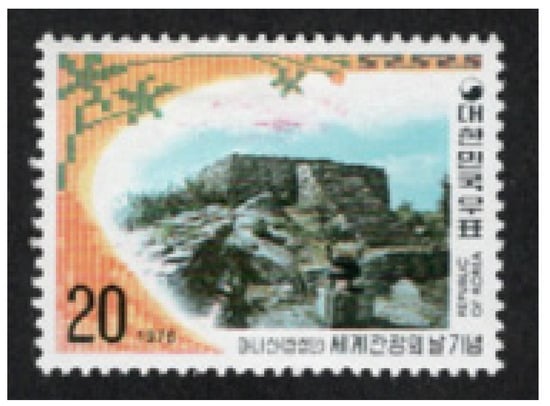
Figure 5.
Mani-san altar, 1976.
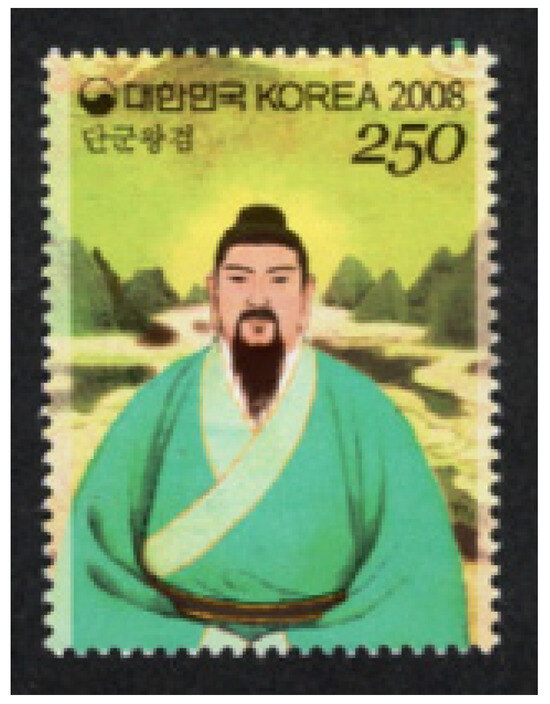
Figure 6.
Tan’gun, 2008.
Perhaps the most surprising finding under the category of ‘cultural history’ was the extremely small number of stamps using Confucian motifs. I have stated that, in my opinion, during the long Chosŏn Dynasty (朝鮮, 1392–1910), Korea became the most Confucianised of all of the nations of East Asia (Grayson 2002, pp. 232–35). Of a total of 209 stamps using ‘religious’ imagery in the icon, only five had an implicit or explicit Confucian theme. The definitive series of stamps issued during the Korean War period in 1952 and again in 1953 (SK 154, SK 162) showed the image of the memorial shrine to Admiral Yi Sunsin (李舜臣, 1545–1598), who had defeated the Japanese navy in the great sea battle of Hansan-do (閑山島) in 1598. In the issue in the Sightseeing Series of 1973 (SK 869), the icon consists of a colourful depiction of the Hongsal-mun (紅살門, Red Arrow Gate) or the ceremonial entrance into the precinct of Yi Sunsin’s shrine. These images are depictions of historic Korean architecture, and implicitly both Confucian (ceremonial) and nationalistic (heroic warrior). In the World Heritage Series of 1999, there are two stamps depicting the Chong-myo (宗廟, Royal Ancestral Shrine, SK 2053) and the musicians and instruments used during the royal ancestral ceremony (SK 2054). The Confucian imagery used in the five stamps references ‘ceremony’ and not ideas or principles.
The fourth theme represented in stamps in the category of ‘cultural history’ is Christianity. There are five stamps issued in the past seventy-five years that use this theme, the same number of stamps issued with a Confucian theme. However, there are no definitive stamps with this theme. Christian-themed stamps are all commemorative stamps. Christian images only appear in the later part of our period, the first (SK 2118, Figure 7) being issued on 1 November, 2000 as part of the Millenium Series. It depicts the Catholic cathedral of Sŏul. Nearly a quarter century later in 2022, a set of four stamps was issued as part of the Historic Buildings Series, depicting both historic Catholic and Anglican churches (SK 3576–3579), two of which were early parish churches.4 These depict the Christian contribution to Korean culture as religious architecture only, and this recognition appears late in the period.
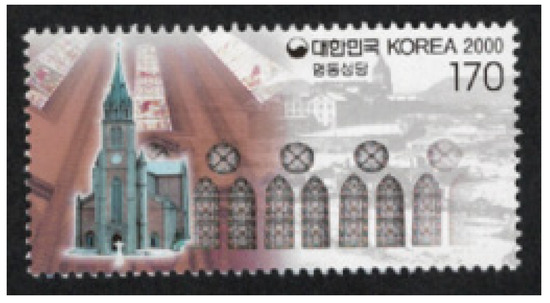
Figure 7.
Myŏngdong Cathedral, 2000.
3.1.2. North Korea5
Buddhist imagery first appears on North Korean stamps in 1957 with the depiction of the Tabo-t’ap pagoda (NK 174), which had appeared on a South Korean stamp (SK 54) eight years earlier. In the following year, North Korea issued a stamp depicting a Buddhist ceremonial object (NK 192) and two stamps of the Wŏljŏng-sa temple (月精寺) and its pagoda (NK 193–194, Figure 8). Interestingly, this temple is also in South Korea. No stamps using a Buddhist theme were issued in the 1960s. The four stamp issues of 1977 with a Buddhist theme were all depictions of ritual objects (NK 1646, NK 1648, NK 1649, NK 1677). The next Buddhist depiction is on a minisheet (NK 2492) for the philatelic exhibition in Bangkok in 1983, and it is of a Thai, not a Korean, temple. Three years later, there is a depiction of the temple on Myohyang-san in North Korea (NK 2835), but the next Buddhist image is not until 1994, when there is a reference on a set of six registered-mail labels to the Wang och’ŏnchukkuk-jŏn (往五天竺國傳, Record of a Journey to the Five Kingdoms of India), a ninth-century Korean monk’s record of his time in the sub-continent (NK 3693–3698). A Buddhist rock sculpture appears in 1995 (NK 3824). Buddhist imagery does not appear again until 2003. From then, Buddhist imagery appears yearly until 2009, and again in 2012 and 2013. Most recently, Buddhist images appear on stamps in 2019, 2020, and 2021. These stamps are usually of temples or ritual objects, but it is interesting to note that the two issues of 2009 (NK 5575–5576) are for the China Stamp Exhibition of that year and depict Buddhist temples, one of which is Chinese. Likewise, the two 2019 issues (NK 6747–6748) are for the World Stamp Exhibition CHINA 2019 in Wuhan and depict two Buddhist pagodas, one of which is Chinese. The final depiction is on the New Year’s stamp for 2021, which displays a Korean temple bell (NK 6890).
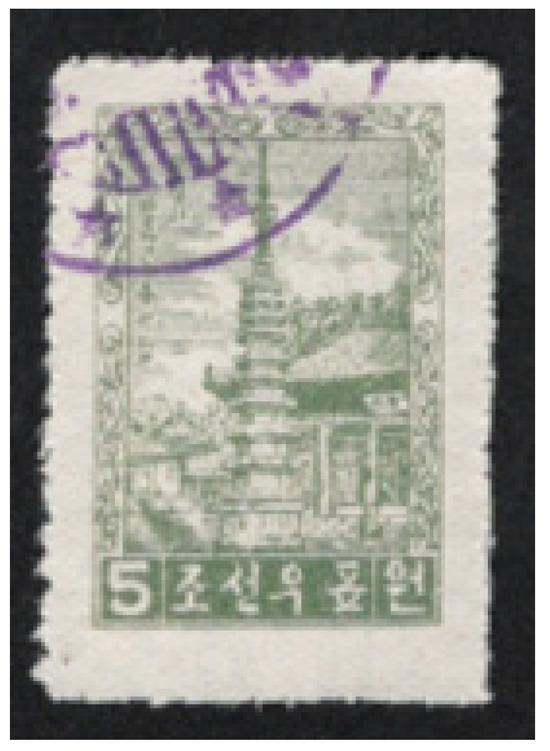
Figure 8.
Wŏljŏng-sa temple and pagoda, 1958.
Of a total of 96 North Korean stamps with a cultural history theme issued in the period, only 18 (19 percent) contained Buddhist imagery, and, in some cases, these images were not Korean. This contrasts with South Korea, where nearly half of the stamps issued on cultural history used a Buddhist theme. Moreover, the number of South Korean cultural history issues was four times greater than the number of North Korean issues, in spite of the fact that, overall, South Korea issued roughly half of the total number of postage stamps of any kind compared with North Korea.
The number of North Korean stamps with a cultural history theme that use folkloric themes is the same percentage as South Korean issues, around 40 percent of the theme. Whereas South Korea issued 66 stamps using a folklore theme, North Korea issued only 40. The first stamp on this theme was issued in 1958, depicting a celadon vessel in the shape of a dragon (NK 191, Figure 9). In 1960, 1964, and 1966, stamps were issued showing shamanic dancing (NK 272 (Figure 10), NK 582, NK 779). A decade later, in 1975, a series of four stamps was issued from ancient wall paintings depicting folkloric animals, such as the blue dragon (NK 1380), the white tiger (NK 1381), the phoenix (NK 1382), and the sacred tortoise (NK 1383). A significant shift in the use of folkloric images occurs from 1980. The New Year’s issue for that year (NK 1994) depicts Ch’ŏn-ji (天池, Heavenly Lake), which fills the crater of the extinct volcano Paektu-san, the place where the Myth of Tan’gun says that Tan’gun’s father, the son of the Ruler of Heaven, descended to earth. This imagery is connected with Kim Ilsŏng and his descendants from this time on. After this, there are only two series of stamps on a folkloric theme that do not relate to this foundation myth. A series of five stamps was issued in 1993 on the theme of the Sip changsaeng (NK 3818–3822), and in 1999, two minisheets of six stamps each depicted the twelve animals associated with the East Asian lunar calendar (NK 4373–4384). From 1995, stamps with a folkloric theme are connected to the Myth of Tan’gun. A series of four stamps and a minisheet were issued in 1995 depicting the reconstruction of the tomb of Tan’gun and associated relics (NK 3832–3835, Figure 11). In the millennial year 2000, a set of three stamps was issued that depicted Paektu-san, two of which are scenes of Ch’ŏn-ji (NK 4407–4409). Again in 2012, a set of two stamps was issued showing Paektu-san, one of which is of Ch’ŏn-ji (NK 6014–6015). In the following year, a minisheet of four stamps all depicting Paektu-san (NK 6164–6167) was issued, two of which showed scenes around Ch’ŏn-ji.
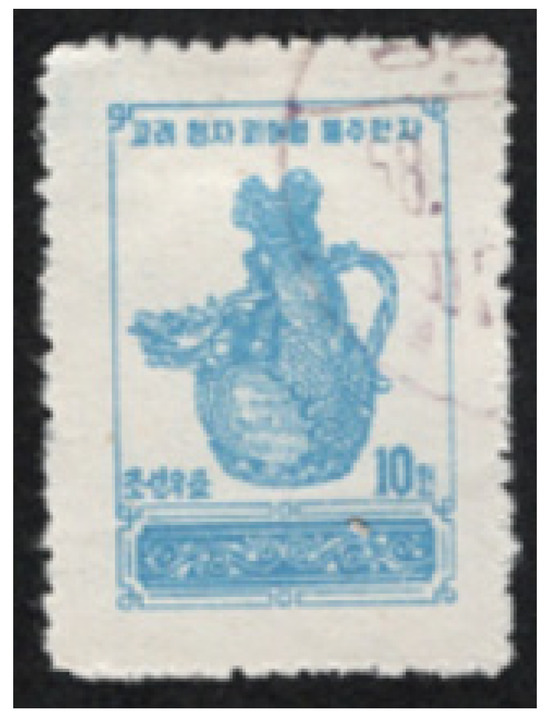
Figure 9.
Koryŏ ceramic vessel, 1958.
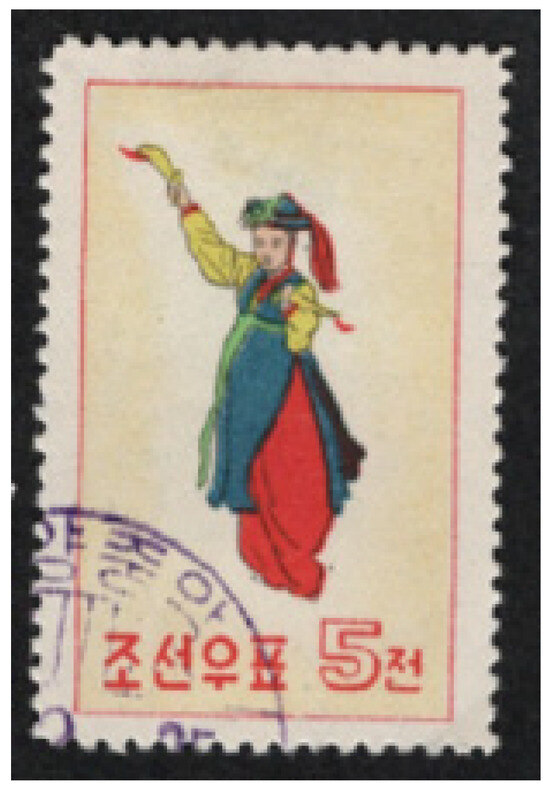
Figure 10.
Dancing mudang (shaman), 1960.
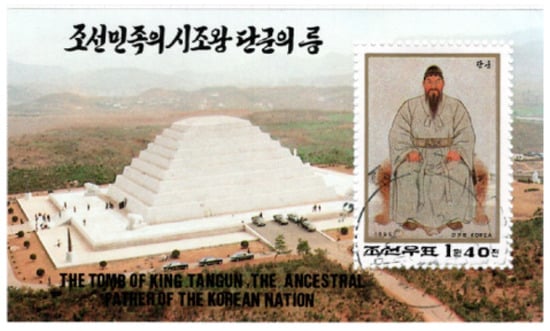
Figure 11.
Tan’gun minisheet, 1995.
Of the 40 cultural history stamps with a folkloric theme, around a third depict scenes related to the Myth of Tan’gun, principally the mountain associated with the heavenly descent of Tan’gun’s father. Compared with South Korea, North Korea has placed greater emphasis on the sacred mountain. In the course of the development of the cult of the leader, strong associations were made with the mountain being the base for the revolutionary hero (NK 1127) and as the place where Kim Chŏngil (金正一, 1941–2011), Kim Ilsŏng’s son and successor, was born. One of the peaks on the Paektu-san range was named after him, Chŏngil-pong (正一峯, NK 3381, NK 3826). Although South Korea has referred to the myth by depicting an altar dedicated to the worship of Tan’gun, images of Ch’ŏn-ji, or the narrative scenes of the myth, it has also depicted the narrative scenes of foundation myths other than the Myth of Tan’gun. Importantly, South Korean motifs associate the Tan’gun Myth with the nation, and not with an individual person or family.
In the category of cultural history in North Korean stamps, there are no references to Confucian motifs. What is surprising is that roughly forty percent of stamps in this category use Christian motifs. These motifs appear in 1983 and cease in 1999. None of these stamps refer to Korea. The first appearance of a Christian motif is a stamp commemorating the stamp exhibition in Cologne in 1983 presenting a classic picture of the Nativity of Christ (NK 2433). Subsequent stamp exhibitions that are commemorated include the 1985 exhibition in Buenos Aires showing two churches (NK 2270), a stamp for the exhibition in Rome, also in 1985 (NK 2804), depicting the Virgin and Child, the minisheet for the 1986 exhibition in Sydney (NK 2870) showing St. Mary’s Catholic Cathedral in the background, and the stamp exhibition of 1998 in Milan, commemorated by a minisheet prominently showing the city’s cathedral (NK 4328). North Korea not only celebrated philatelic exhibitions; in the decade of the 1980s, they also commemorated European artists and issued stamps of paintings with Christian themes. In March 1983, they commemorated the five-hundredth anniversary of the birth of Raphael by issuing a set of three stamps, all on the theme of ‘The Virgin and Child’ (NK 2443–2445). In December of the same year, they commemorated the four-hundred-and-fiftieth anniversary of the death of Antonio Correggio by issuing a set of three stamps (NK 2529–2531), a minisheet of one stamp (NK 2532), and a minisheet of four stamps (NK 2533–2536), all of which depict Christian religious themes, principally the Virgin Mary, or ‘The Virgin and Child’. Christian imagery also appears for miscellaneous events, such as on the minisheet for the 1985 World Cup in Mexico (NK 2814), the celebration of the left-wing newspaper L’Unita in 1986 (NK 2872), the cross on the flag of Columbus’s ship (NK 3016) in 1988, and the minisheet celebrating the return of Macau to China in 1999, which shows the dramatic ruins of St. Paul’s Church (NK 4398). The heyday of the use of Christian imagery is in the 1980s, and it is focussed on foreign cultures. There is no Korean Christian imagery. This contrasts with South Korean issues in the same cultural history category, which reference Christian contributions to Korean religious architecture.
3.2. Commemoration of Buddhism
3.2.1. South Korea
If Buddhist motifs dominate the representations of ‘religion’ in the category of cultural history on South Korean stamps, stamp issues celebrating some aspect or event of Buddhism are very few. Only seven stamps in the whole corpus would fall into this category. If uses of Buddhism as symbols of Korean history and culture appear early with the issuance of a definitive stamp of the Tabo-t’ap pagoda in 1949 (SK 54), imagery actually promoting Buddhism does not appear until 1976, nearly three decades later. This stamp (SK 1040, Figure 12) commemorates the UNESCO campaign to preserve the great Buddhist temple complex at Borobudur on the island of Java. In the following year, a stamp celebrating the two-thousand-and-six-hundredth anniversary of the Birth of the Buddha was issued (SK 1076, Figure 13), depicting the great Buddha figure in the Sŏkkur-am grotto (石窟庵) outside of Kyŏngju. An image of this sculpture first appeared on a definitive stamp in the war-time series of 1952 (SK 143). SK 1076, however, uses the same motif of the grand Buddhist sculpture not to promote a positive image of Korean culture and history but to celebrate Buddhism and its founder. This is a shift in the presentation of Buddhism on South Korean commemorative stamps. However, it is not until 2004 that another stamp is issued that celebrates Buddhism. In November of that year, a set of nine ‘Greetings Stamps’ was issued. These were in bright colours and done in a cartoonish style. One of these, SK 2433, depicts two smiling, boyish-looking monks seated behind a pink lotus flower. This radiates a sense of joy, but there is no text connecting the image with Buddhism. It is expected that the viewer would understand the references. In 2006, a commemorative stamp was issued to celebrate the one-hundredth anniversary of the Buddhist university, Dongguk University (東國大學校, SK 2512). In 2014, for the first time, an eminent Buddhist was commemorated on a stamp (SK 2977). Han Yongun (韓龍雲, 1879–1944), better known by his Buddhist name as Manhae (萬海/卍海), was a great twentieth-century moderniser of Buddhism, a poet, and a nationalist during the Japanese occupation (Pratt and Rutt, p. 158). This stamp formed part of a three-stamp series on significant twentieth-century Korean figures. In 2016, two stamps were issued, one (SK 3117) celebrating the one-hundredth anniversary of the founding of Wŏn Pulgyo (圓佛敎) (Grayson 2002, pp. 212–15; Cawley 2019, pp. 156–61), a reformed type of Buddhism that originated in Korea, and the other a head-and-shoulders portrait of Sŏngch’ŏl (性徹, 1912–1993), one of the leading monks of the Chogye order (曹溪宗), the principal denomination of Buddhism in South Korea. This was one of a two-stamp set, the other stamp being dedicated to the Cardinal Archbishop of Sŏul.
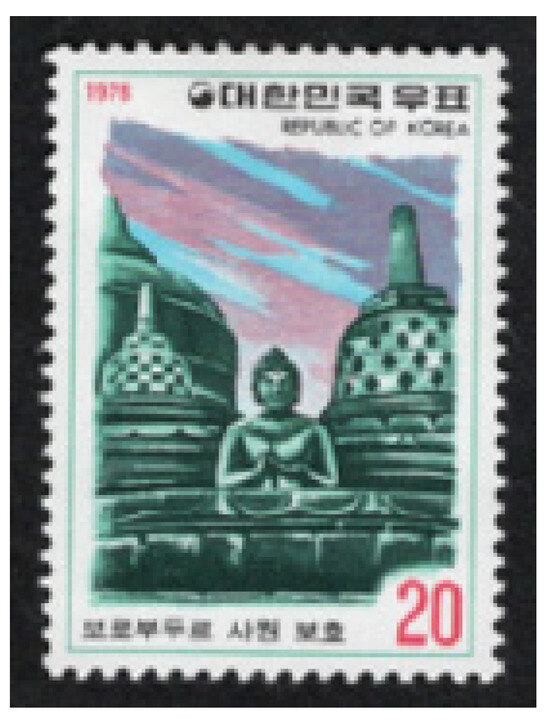
Figure 12.
Borobudur temple in Java, 1976.
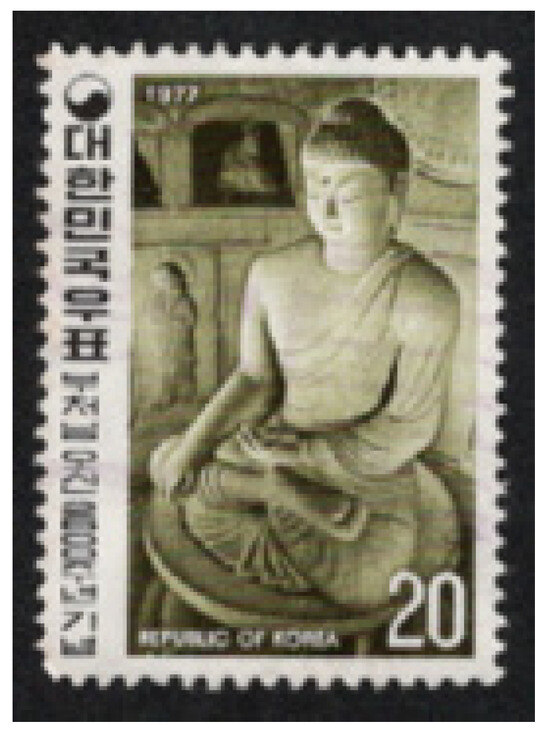
Figure 13.
Sŏkkur-am grotto, Kyŏngju, 1977.
3.2.2. North Korea
Throughout the entire seventy-five-year period under consideration, there were no stamps issued by the DPRK that promoted, celebrated, or commemorated Buddhism, as opposed to using Buddhist motifs in cultural-history-focussed stamp issues.
3.3. Commemoration of Confucianism
South and North Korea
In spite of the overwhelming influence of Neo-Confucianism on all aspects of Korean society, culture, and politics, Confucianism is poorly represented in the semiotic aspects of the corpus, with just a few references for the category of cultural history in South Korean stamps. There are no images in the icons of the stamps outside of this category that I felt could be classified as highlighting or commemorating Confucianism.
3.4. Commemoration of Christianity
3.4.1. South Korea
Over the seventy-five-year period of national independence, 29 of the 209 South Korean stamps that used religious themes to promote, celebrate, or commemorate some aspect of religion used Christian themes and motifs. Christian-themed stamps were issued early (from 1953) to the last year of the period. The first commemorative stamp that was issued just after the Korean War in 1953 celebrated the fiftieth anniversary of the foundation of the Korean YMCA (SK 168, Figure 14). The YMCA and its affiliate organisations were celebrated throughout the period. In 1964, the fiftieth anniversary of the foundation of the association of local YMCAs was celebrated (SK 413); the seventy-fifth anniversary of the founding of the YMCA was commemorated in 1978 (SK 1130); the fifty-fifth anniversary of the Y’s Men’s Clubs and its world meeting in Sŏul was celebrated in 1982 (SK 1280), as was the World Assembly of the YMCA in Sŏul in 1991 (SK 1673); and the one-hundredth anniversary of the Korean YMCA was commemorated in 2003 (SK 2366). The equivalent woman’s group, the YWCA, was also celebrated on stamps in 1962 (fortieth anniversary, SK 341), in 1972 (fiftieth anniversary, SK 825), in 1982 (sixtieth anniversary, SK 1268), and in 2022 (centenary anniversary, SK 3564).

Figure 14.
Korean YMCA fiftieth anniversary, 1953.
The foundation of Christianity and specific Christian denominations in Korea also formed a sub-theme within the broad theme of the commemoration of Christianity, although it did not appear until midway through the period. The two-hundredth anniversary of the foundation of Roman Catholicism in 1984 was celebrated by a single stamp with a stylised cross (SK 1352, Figure 15) and by two subsequent stamps to commemorate the visit of Pope John Paul II in the same year (SK 1361–1362, Figure 16), the first time a Christian figure had been presented on a Korean stamp. This was thirty years before the representation of a Buddhist figure, Manhae, in 2014. Later on in 1984, the centenary of the arrival of American Protestant missionaries (Methodists and Presbyterians) was commemorated on two stamps (SK 1373–1374, Figure 17) using a stylised crucifixion motif. The hundredth anniversary of the foundation of the Anglican Church in Korea was remembered in 1990 (SK 1635), as well as the centenary of the Salvation Army in 2008 (SK 2665). Beyond this, the centenary of the foundation of the Korean Bible Society was celebrated in 1995 (SK 1851) showing an open Bible, and the hosting of the forty-fourth Roman Catholic Eucharistic Conference in Sŏul in 1989 (SK 1600).
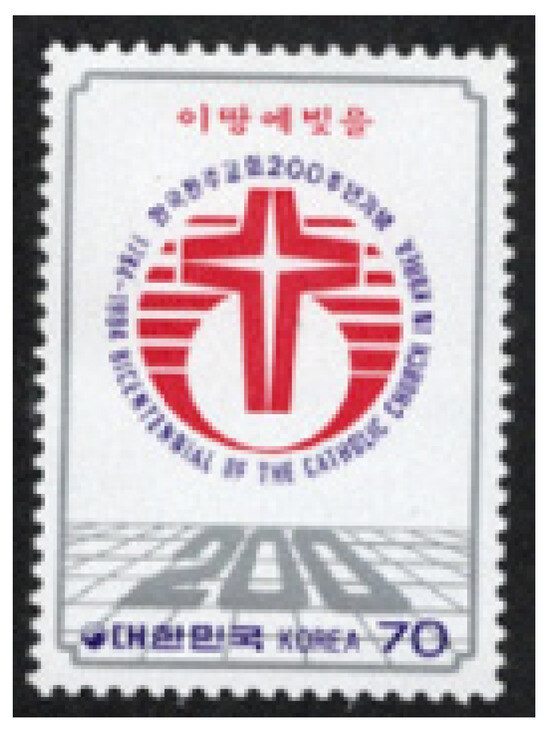
Figure 15.
Korean Catholic bicentennial, 1984.
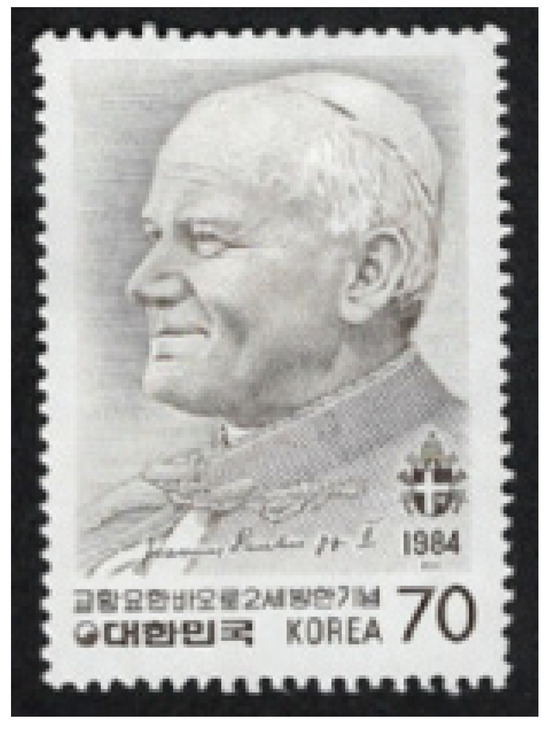
Figure 16.
Visit of Pope John Paul II to Korea, 1984.
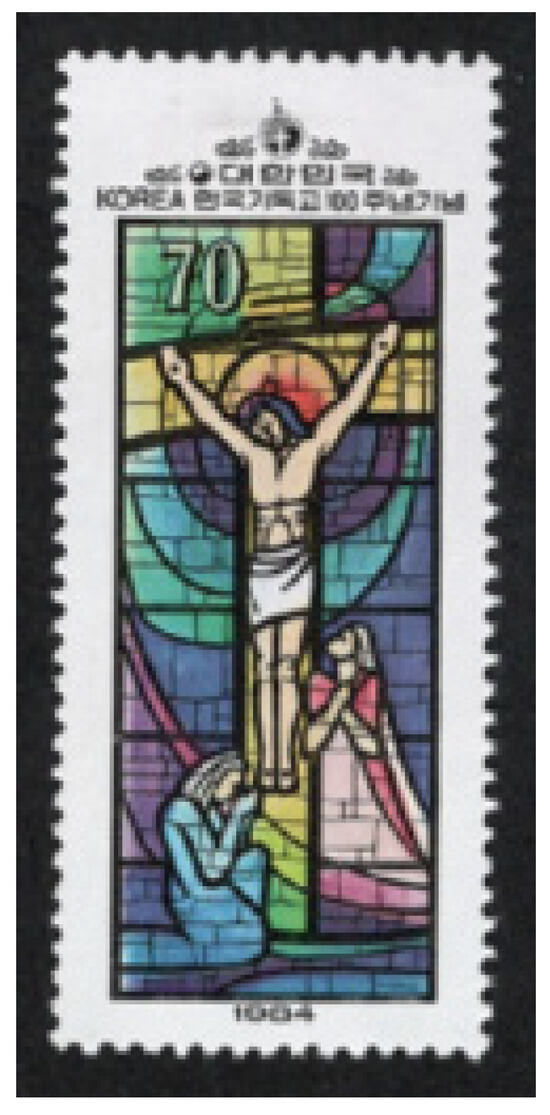
Figure 17.
Korean Protestant centennial, 1984.
Higher education in South Korea is a very important aspect of life, and this is represented in stamp design with the recognition of the foundation of Christian universities, beginning with the centenary of the founding of Soongsil University (崧實大學校) in P’yŏngyang in 1897 (SK 1939) by a Presbyterian missionary, William Baird (1862–1931). Subsequent Christian universities that were commemorated by South Korean stamps include the centenary of Sahmyook University (Samyuk University, 三育大學校, SK 2532) in 2006, which has Seventh Day Adventist origins, the centenary of Chungang University (中央大學校, SK 3330) in 2018, which has Methodist roots, and the centenary of Duksung Women’s University (Tŏksŏng Women’s University, 德成女子大學校, SK 3440) in 2020, which has Roman Catholic roots.
Individual Christians began to appear on commemorative stamps, as we have seen with two stamps for Pope John Paul II in 1984. In 1986, a definitive stamp featuring the key late Chosŏn scholar Chŏng Yagyong (丁若鏞, 1762–1836, SK 1475, Figure 18) was issued. Tasan (茶山), as he was known by his literary name, is an ambivalent figure, who at an early stage had been a Catholic (as were many of his own relatives) and then under pressure said that he rejected Catholicism. Some argue that he remained a secret Catholic (Cawley 2019, pp. 104–5). Whatever the situation may actually be, it is significant that he, as someone who at least at some point in his life had been a Christian, is not only remembered but is remembered on a definitive stamp, not a commemorative stamp. The eminent Cardinal Archbishop of Sŏul, Kim Suhwan (金壽煥, 1922–2009), is commemorated on a stamp from 2016 (SK 3126) in the same series as the leading Buddhist monk Sŏngch’ŏl. In 2021, the two-hundredth anniversary of the birth of Kim Taegŏn (金大建, 1821–1846), the first Korean to be ordained as a Catholic priest and a martyr, was celebrated on a stamp (SK 2535). Three other Christians were remembered on South Korean stamps. In 2022, Gregor Mendel (1822–1884, SK 3602), a Catholic priest and scientist, and Homer Hulbert (1863–1949, SK 3606), a former Methodist missionary, were commemorated. In 2023, Frank Schofield (1889–1970, SK 3691), a Canadian missionary was remembered. Mendel was commemorated because of his scientific research, and the two missionaries commemorated were part of a series remembering foreign nationals who had supported Korean independence from Japan. In 2004, a series of MYOWN stamps was issued. We have referred to the stamp that had two Buddhist monks in its design. A Christian stamp in this series shows a lamb reading an open Bible (SK 2433). The Bible has a cross on it, and in the background there is a church with a cross atop its steeple. Although not human, the lamb can be seen to be representative of an ordinary, devout Christian reading the Bible. What is interesting about the six people selected to represent Christianity is that four are Catholics, of whom three are Korean, whereas the representative Protestants are foreign.
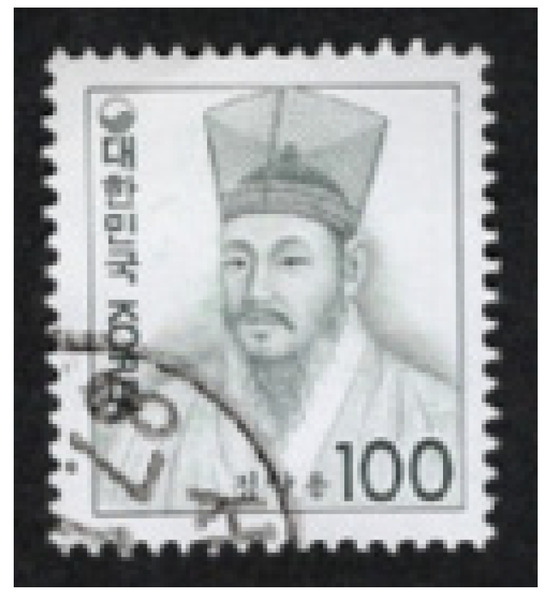
Figure 18.
Chŏng Yagyong, definitive stamp, 1986.
3.4.2. North Korea
In the whole corpus of North Korean stamps, there are only four stamps that use ‘Christian’ imagery, and three of them are ambiguous. Chŏng Yagyong is commemorated twice on DPRK stamps, once in 1962 (NK 479) and again in 2011 (NK 5967). In the former example, it is a half-portrait of him in the costume of a scholar, whereas in the latter example, he is shown seated in his study surrounded by the items of a scholar. In either case, it would seem that he is being commemorated as a great scholar, as there are no indications of any attachment to Christianity. The second person to be commemorated (in 2000 on NK 4490) is Mun Ikhwan (文益煥, 1918–1994), a renowned South Korean New Testament scholar. In this case, he is unambiguously Christian, but he is commemorated as a leading opponent of the South Korean governments of his time. He received in person a medal from the North Korean Government. None of these figures are being commemorated because of any association with Christianity but for cultural or political reasons.
The fourth stamp in the corpus is unambiguously Christian. In 2015, North Korea commemorated the opening of a Russian Orthodox Church in P’yŏngyang (NK 6372). The building depicted is a typical Orthodox cruciform church with two golden onion-skin domes, each topped by a golden cross. Although there is also a Protestant and a Catholic church in the DPRK capital, these have not been commemorated (Cawley 2019, p. 172). It is important to remember that before the end of the Japanese colonial period, northern Korea had the predominant number of Christians, and P’yŏngyang was the centre of Protestant Christianity (Cawley 2019, p. 145).
3.5. Miscellaneous Themes and Motifs
3.5.1. South Korea
Buddhist motifs and imagery appear on disparate types of commemorative stamps showing that ‘Buddhism’ is seen as a representative feature of Korean history and culture. The fiftieth anniversary in 1977 of the founding of the Rotary Clubs in Korea is commemorated by a stamp displaying the Rotary wheel symbol superimposed on a temple bell (SK 1093, Figure 19). The thirtieth anniversary of the foundation of the Republic of Korea in 1978 was celebrated with a picture of a temple bell being struck with a view of Ch’ŏn-ji in the background (SK 1120, Figure 20), bringing together Buddhist and folkloric imagery. Buddhist imagery again appears with a representation of a Maitreya Buddha figure from the Kingdom of Paekche on the stamp commemorating the opening in 2005 of the new building housing the National Museum (SK 2483), on the stamp celebrating the Silk Road Festival hosted in Kyŏngju in 2015, which showed the Pulguk-sa temple, a pagoda, and two mosques (SK 3081), and on the stamp from 2016, which commemorated the one-hundredth-and-thirtieth anniversary of Franco-Korean diplomatic relations, displaying a Buddhist incense burner (SK 3123).
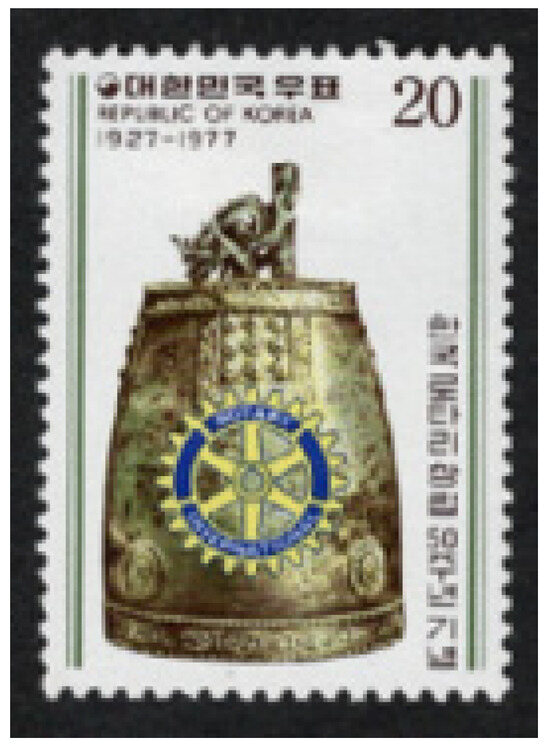
Figure 19.
Korean Rotary Clubs’ fiftieth anniversary, 1977.
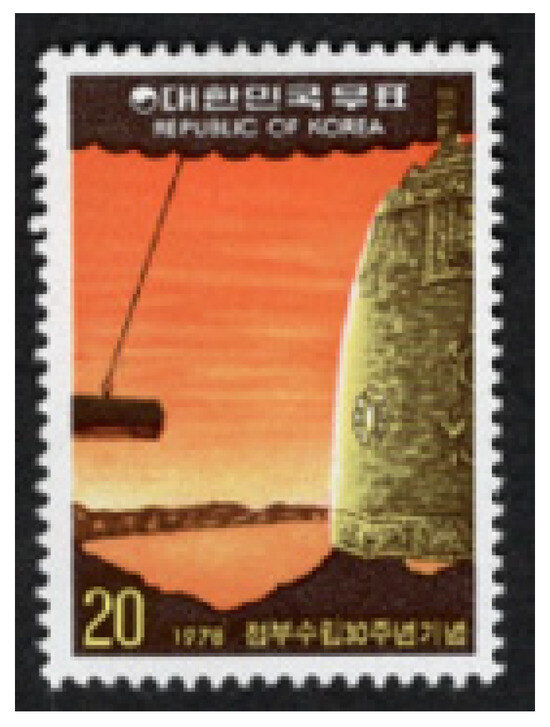
Figure 20.
Thirtieth anniversary of the foundation of the Republic of Korea, 1978.
The folklore motif that occurs over and over again in this diverse category is the image of Ch’ŏn-ji, connecting the ROK state with the foundation myth of Tan’gun. This usage began very early. The South Korean state adopted in 1948 the use of the Tan’gi (檀紀) or Tan’gun calendar to officially date documents (Pratt and Rutt 1999, p. 463) and established a national holiday, Kaech’ŏn-jŏl (開天節, Opening of Heaven Festival), which celebrated the descent to earth atop Paektu-san of Tan’gun’s father.6 On 20 November 1950, when UN forces had seemingly defeated North Korean forces, the ROK Government issued a series of three stamps commemorating national unification, one of which showed the ROK flag flying above Ch’ŏn-ji and the date given according to the Tan’gi calendar (SK 70, Figure 21). In 1955, following the end of the Korean War, a set of definitive stamps was issued to promote and encourage national reconstruction. There are six of these stamps of different values and colours but of the same design (SK 187–190, SK 202–203, Figure 22). The design depicts cupped hands holding up a growing plant, which is flanked on the left by large industrial plants and on the right by a hydro-electric dam. In the background of this scene is Ch’ŏn-ji. This background imagery is used again to celebrate the thirtieth anniversary of the establishment of the ROK in 1978 on SK 1120 as mentioned above and on the stamp issued in 1985 to celebrate the fortieth anniversary of liberation from Japanese rule (SK 1410, Figure 23), showing a photographic image of the crater lake, the image being laced by the national flower.
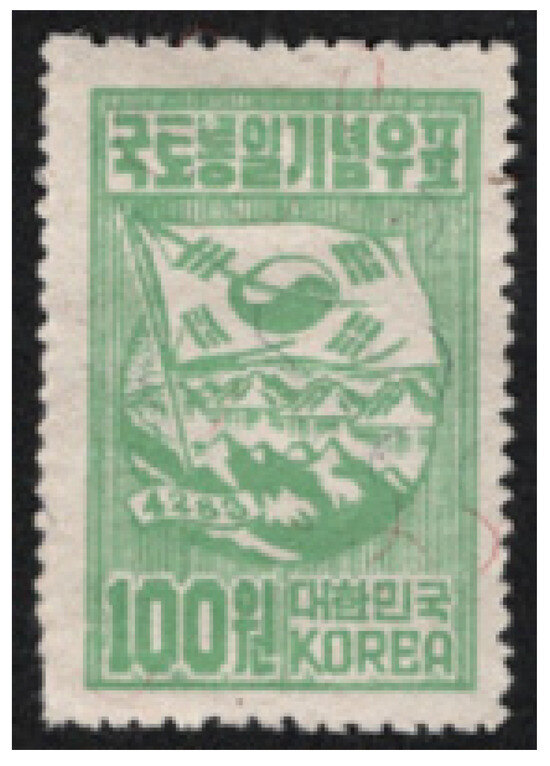
Figure 21.
Celebration of national reunification in the Korean War, 1950.
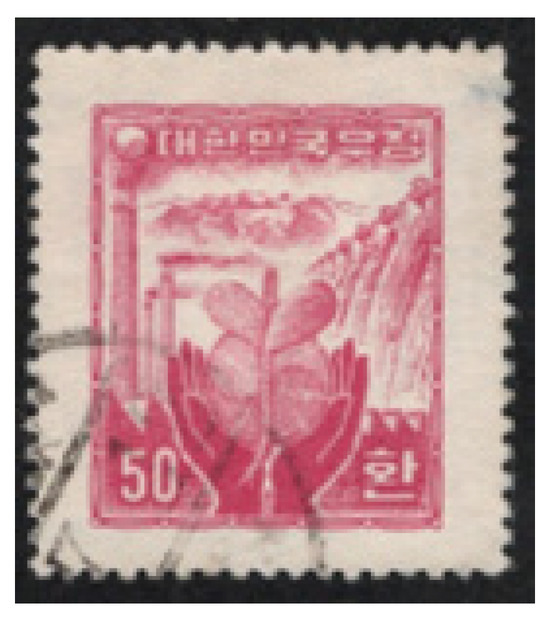
Figure 22.
National reconstruction, definitive stamp, 1955.
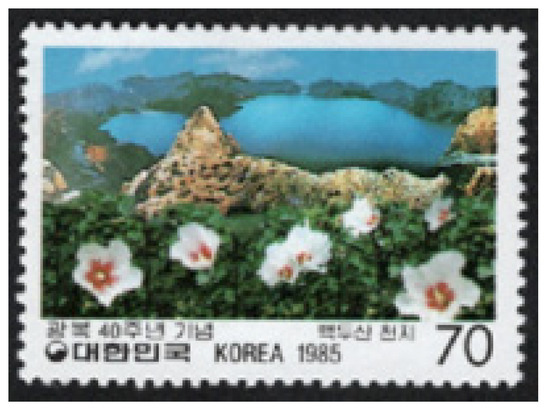
Figure 23.
Fortieth anniversary of national liberation from Japanese rule, 1985.
There are two miscellaneous uses of Christian imagery, all with reference to the war dead of the Korean War. In 1960, a stamp (SK 312, Figure 24) was issued to commemorate the opening of the cemetery for UN soldiers killed in the Korean War. It depicts rows of gravestones in the shape of a Christian cross, a stem capped by a Jewish Star of David, and an Islamic crescent moon with a star. In the following year, Memorial Day was commemorated by a cross-shaped gravestone capped by a helmet (SK 322). Here, the Christian (and Jewish and Islamic) imagery is used not to promote a religious tradition but to give evidence of the diversity of support given to the ROK during the war.
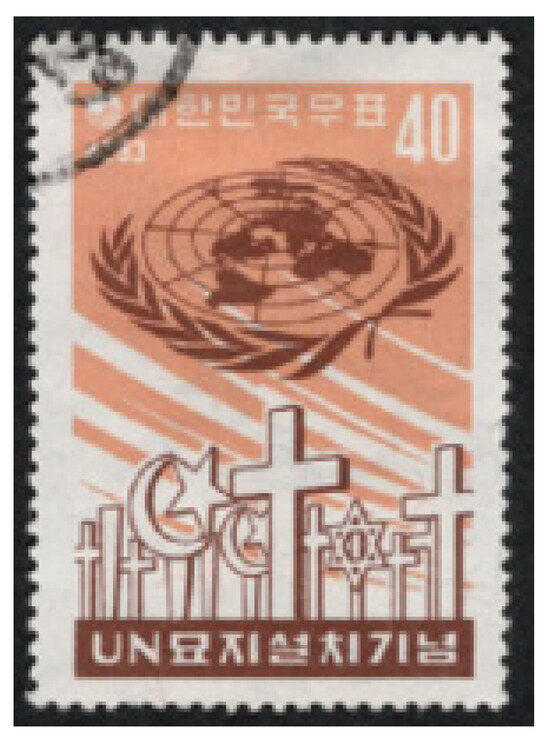
Figure 24.
United Nations Korean War cemetery, 1960.
3.5.2. North Korea
Rather than a broad, miscellaneous-themed category, the North Korean stamps discussed here use one theme, the Myth of Tan’gun, in relation to the growing cult of the leader and the leader’s family. Three topics use an appeal to the Tan’gun Myth by using the motifs of Paektu-san (and its crater lake, Ch’ŏn-ji): (1) national identity, (2) Kim Ilsŏng, founder of North Korea’s ruling family, and (3) Kim Chŏngil, his son and successor. The myth, the sacred mountain, and the crater lake define the legitimacy and authority of the ruling family. Therefore, a study of the imagery of North Korean stamps from 1970 onwards provides evidence for both the progressive centralisation of state power in the hands of Kim Ilsŏng’s family and the rise of the cult of the leader.7
Use of imagery drawn from the myth began in 1970 when a set of four stamps was issued showing scenes of Paektu-san (NK 1000–1003), one of which was of Ch’ŏn-ji (NK 1000). In the following year, another set of three stamps was issued that portrayed views of Paektu-san (NK 1041–1043). In 1994, a set of three minisheets of nine stamps was issued (NK 3663-3669) depicting the flowers of Paektu-san. The use of the mountain as a nationalist symbol appears on a stamp from 1981 celebrating the fifty-fifth anniversary of the founding of the ‘Anti-Imperialist Union’ (NK 2219), which shows the Union’s symbol hovering over the summit of Paektu-san, thereby giving the movement legitimacy. A stamp with a similar design was issued in 2006 showing the flag of the movement flying over Paektu-san (NK 5322), recalling the first South Korean usage of these motifs in 1950 (SK 70).
Stamps clearly affirming Kim Ilsŏng’s association with the foundation myth began in 1972 with a minisheet celebrating the leader’s sixtieth birthday and depicting him atop Paektu-san with Ch’ŏn-ji in the background (NK 1127). The Great Leader’s eighty-second birthday in 1994 is commemorated by a minisheet of five stamps of a connected image, each showing a portion of the great crater lake (NK 3658–3662). Three years later, and three years after the Great Leader’s death, a set of four minisheets with portrait heads of Kim Ilsŏng is issued to celebrate his eighty-fifth birthday. One of these minisheets depicts his portrait above the crater lake, with rays of sunlight streaming from his portrait (NK 4107). In 2001, a stamp is issued depicting a hut, the revolutionary base of Kim Ilsŏng, which is sited on the sacred mountain (NK 4579), and, in 2005, a minisheet (NK 5078) celebrating the sixtieth anniversary of the end of the Second World War shows a portrait of the Great Leader hovering over Ch’ŏn-ji. These posthumous associations of the Great Leader with Paektu-san continue to appear. In 2018, the seventieth anniversary of the foundation of the Korean People’s Army was celebrated with two minisheets, one of which has a stamp portraying the Great Leader with a panoramic view of Paektu-san in the background of the minisheet itself (NK 6625).
The Paektu-san imagery is used even more with regard to the Great Leader’s successor. In 1992, to celebrate Kim Chŏngil’s fiftieth birthday, a set of four stamps depicting Paektu-san was issued (NK 3381–3384), one of which was of Ch’ŏn-ji (NK 3383). A minisheet was also issued at the same time with a stamp depicting the Dear Leader atop the crags of the crater, with the English phrase ‘Mount Paekdu is my native place. Kim Jong Il’ inscribed on the minisheet (NK 3385). As this was two years before the death of Kim Ilsŏng and Kim Chŏngil’s assumption of power, this stamp issue was intended to bolster his claim to be the successor to his father. Again in 2003, a stamp (NK 4777) and a minisheet (NK 4778) depicting Paektu-san were issued to celebrate the Dear Leader’s sixty-first birthday. These issues depict the Chŏngil-pong peak, which is part of the mountain range and named for the Dear Leader. Two years later, in 2005, a stamp was issued to celebrate the Dear Leader’s sixty-third birthday, depicting the Chŏngil-pong (NK 5016). For the same event, two minisheets of four stamps each were issued, depicting panoramic views of Ch’ŏn-ji in two seasons (NK 5017–5022). Again, the Dear Leader’s sixty-fifth birthday was celebrated with a minisheet of four stamps, which together provided a panoramic view of Ch’ŏn-ji (NK 5346–5349). His seventieth birthday was celebrated with the issuance of two minisheets, one of which depicts him atop Paektu-san with the crater lake in the background (NK 6035). Although he had died in the previous year, his birthday was celebrated and continued to be celebrated using the normal imagery, as had been the case with his father’s birthday. His seventy-first birthday was celebrated with the issuance of two stamps and two minisheets, one of which shows Chŏngil-pong (NK 6131). In 2018, the Dear Leader’s birthday continued to be celebrated with the issuance of a stamp (NK 6628) and two minisheets, the stamp depicting Chŏngil-pong and the revolutionary hut. In 2020, two stamps were issued for Kim Chŏngil’s birthday, one depicting Chŏngil-pong (NK 6799), and the other Ch’ŏn-ji (NK 6800), clearly linking the deceased Dear Leader to the lineage of the Myth of Tan’gun. This imagery is repeated for his birthdays in 2021 (NK 6895) and again in 2022 on a stamp and a minisheet (NK 6993–6994). The birthday issues of 2023 do not use the Paektu-san imagery.
In 2020, for the first time, a minisheet of one stamp (NK 6833) is issued depicting Kim Chŏngŭn, son and successor to the Dear Leader since 2011, standing by a snow- and ice-covered Paektu-san and its crater lake, thus asserting continuity with his father and grandfather and asserting his own legitimacy through his connection with the mythic story of Korean origins. This myth is a powerful means for both the assertion and the transmission of political power and authority.8
4. Final Reflections
The semiotic analysis of the imagery on the postage stamps of North and South Korea shows some significant differences and interesting convergences in the motifs they use to project their respective governments’ views on religion and religious practice. The overwhelming number of South Korean stamps using Buddhist and folkloric images contrasts with the significantly lesser use of Buddhist images on North Korean stamps. Moreover, around 1970, folkloric images on North Korean stamps changed from a general projection of Korean folk culture to the use of the Myth of Tan’gun to bolster the developing cult of the leader. In South Korea, folkloric motifs reference Korean culture in general, and the Myth of Tan’gun refers to the nation as a whole, not a particular family.
Confucian imagery is virtually absent as a representation of cultural history and completely absent from stamp design, which could commemorate some aspect of Confucianism both North and South. Christianity, on the other hand, has only a small representation on South Korean stamps as an aspect of cultural history (and only appears on fairly recent stamps), but on commemorative stamps, Christian-themed stamps are significantly greater than Buddhist-themed stamps. They appear at an early period in the ROK’s life and continue as a consistent theme until the present. Buddhist-themed commemorative stamps only appear late in the Republic’s history, and the number of issues is considerably fewer than for Christian-themed ones. There are only a handful of North Korean Christian-themed stamps, and these, with one exception, refer to foreign nations.
There are interesting examples of a convergence in the usage of motifs. Perhaps the earliest example is the intricately designed Tabo-t’ap pagoda of the Pulguk-sa temple of South Korea, which appears on early stamp issues of both North and South Korea. Another example might be the ambiguous use made by the North and South of images depicting Chŏng Yagyong, Confucian scholar and crypto-Catholic. The preeminent convergence is the use made by both North and South Korea of motifs relating to the Myth of Tan’gun. However, the purpose in using these motifs is different. In South Korea, the Tan’gi calendar dates appear on stamps up to the early 1960s, and, throughout the period, motifs related to the myth are used, such as the altar on Mani-san and the great crater lake Ch’ŏn-ji. South Korean use of Tan’gun motifs is very early, being used to create a sense of nationhood. Extensive North Korean use of the motifs is later, and it is used almost exclusively to bolster the legitimacy of the Great Leader and, subsequently, his descendants.
While both states have used Buddhist imagery to project positive images of Korean culture and history, only South Korea has used images to promote or celebrate Buddhism itself. While South Korea has used a few Christian images to project the nation’s cultural history, throughout its existence, the Republic has produced numerous stamp issues actually celebrating some aspect of Christianity. North Korea has produced almost nothing that celebrates Christianity. How are we to account for these differences in the use of religious imagery on North and South Korean stamps?
The key difference must lie in the socio-political climate of each of the states. While both states have a strong sense of nationalism, Christian politicians have dominated the political scene in South Korea since its inception. Cawley (2019, p. 185) has discussed the role of Christianity in Korean politics, but Chong-shin Park in Protestantism and Politics in Korea (Park 2003) has described in detail the growth and influence of Protestantism on the Republic, making clear the extensive influence (explicit and implicit) on the social and political life of South Korea. A more detailed study of the discussions within the South Korean Government or Korea Post about the design of stamps would reveal how these decisions were made, but clearly there was a favourable attitude towards Christianity. Nonetheless, it is important to note that no Christian images appeared on definitive stamps but only on commemorative ones.
The socio-political situation in North Korea was different from its inception in 1948 as a communist state. Marxist views would have restrained the use of any designs that could be seen to be promoting any religion. Consequently, the only religious images seen on North Korean stamps either refer to Korean history and culture, or they are foreign, non-Korean images. The growth of the cult of the leader is reflected in the use of folkloric or mythic images (Myth of Tan’gun) from 1970 onwards, and especially after 1980, when preparation is made for a (then distant) succession. It is interesting to note that the vast number of Christian images on North Korean stamps occurs in the 1980s and early 1990s, and none of them are Korean. While South Korea could celebrate foreigners and missionaries, such as Homer Hulbert and Frank Schofield, who supported Korean independence from Japan, Christianity was depicted as an aspect of a foreign culture in a place distant from Korea. As a part of overseas, foreign culture, these representations of Christianity could pose no threat to the developing cult of the leader. However, by the 1990s, all images that might detract from the narrative of the cult of the leader cease to be used.
In South Korea, the favourable attitudes to Christianity must also have influenced the use of non-Christian religious images on stamps. It is an interesting statistic that although North Korea has produced nearly twice as many stamps of all types as South Korea over the seventy-five-year period, South Korea has produced significantly more stamps with religious imagery, at 209 issues compared with 139 issues in the North. The number of South Korean issues with a religious theme constitutes nearly six percent of the total number of South Korea stamp issues, whereas the number of North Korean issues with a religious theme is just under two percent of the total number of issues. This result clearly reflects a difference in the socio-political climate of the two states.
Stamps are government documents. Through the semiotic analysis of the designs on them, a government’s policies, interests, and programmes can be revealed, supplementing facts known from other sources. Comparative analysis of stamp issues between two states of similar cultural background (such and North and South Korea) may reveal or highlight socio-political features, as shown in this study, where the attitudes towards religion and religious practice are clearly, visibly discerned.
Funding
This research received no external funding.
Data Availability Statement
No new data were created for this study. Data sharing is not applicable to this article.
Conflicts of Interest
The author declares no conflict of interest.
Notes
| 1 | An on-line description of the origin and legal establishment of this public holiday may be found at https://en.wikipedia.org/wiki/National_Foundation_Day_(Korea)/ accessed on 29 April 2024. |
| 2 | Jinwung Kim (2012, pp. 452–58) discusses how Kim Ilsŏng came to dominate North Korea. On pages 457–58, he describes the rise of the cult of the leader and Kim’s use of the myth associated with Tan’gun. Cawley (2019, pp. 167–68) discusses the rise of the cult of the leader in relation to the concepts of Juche (self-reliance), and the Great Leader as the Father of the nation. |
| 3 | I have discussed the historic and modern uses of the Tan’gun Myth in Grayson (2001, pp. 54–58). A further discussion may be found in Grayson (2015). The text of the myth may be found in Grayson (2001, p. 31). |
| 4 | Another digital source of information is the stamp database colnect (www.colnect.com) which has extensive information on individual stamp issues, but uses a day-date catalogue system which is difficult to use for research purposes. |
| 5 | Stamps mentioned as being in the StampWorld catalogue will be referred to by the StampWorld catalogue number. Stamps for North Korea will be identified as NK plus the catalogue number, while South Korean stamps will be identified as SK plus the number, thus, NK 101, or SK 101. These letter designations do not appear with the catalogue numbers in the appropriate section of the StampWorld catalogue, but are given here to make clear to the reader which nation is being referenced. |
| 6 | ‘Minisheet’ or ‘minature sheet’ refers to sheets of paper containing one or more stamps, usually on a specific theme, and which have a design which surrounds the stamp or which is incorporated into the design of the stamp or stamps (Mackay 2003, p. 87). Catalogue numbers will be assigned to each stamp on a sheet. In recent decades, North Korea has made extensive use of the issuance of minisheets. |
| 7 | The StampWorld catalogue, which is the basis of our corpus, includes a repeat of the same four images giving them the successive numbers SK 3580–3583 because these stamps are part of a minisheet. However, as they are the exact same stamp, I have not counted them as a separate stamp for the purpose of analysis, and have not included these numbers in my calculations. |
| 8 | In this next section, the definition of ‘cultural history’ has been broadened to include world culture because North Korean stamps also depict images which are not Korean. This contrasts with South Korean stamps which never depict anything which is not ‘Korean’ unless there is some direct connection. |
References
- Brunn, Stanley D., ed. 2023. Stamps, Nationalism and Political Transition. London and New York: Routledge. [Google Scholar]
- Cawley, Kevin N. 2019. Religious and Philosophical Traditions of Korea. London and New York: Routledge. [Google Scholar]
- Child, Jack. 2008. Minature Messages: The Semiotics and Politics of Latin American Postage Stamps. Durham: Duke UP. [Google Scholar]
- Grayson, James Huntley. 2001. Myths and Legends from Korea: An Annotated Compendium of Ancient and Modern Materials. Richmond: Curzon. [Google Scholar]
- Grayson, James Huntley. 2002. Korea: A Religious History. Revised Edition. London and New York: RoutledgeCurzon. [Google Scholar]
- Grayson, James Huntley. 2015. ‘Tan’gun and Chumong: The Politics of Korean Foundation Myths. Folklore 126: 253–65. [Google Scholar] [CrossRef]
- Grayson, James Huntley. 2023. Post-Liberation Korea—The First Postage Stamps: A Comparative Semiotic Study of Nation-building in North Korea and South Korea. In Stamps, Nationalism and Political Transition. Edited by Stanley D. Brunn. London and New York: Routledge, pp. 42–58. [Google Scholar]
- Kim, Jinwung. 2012. A History of Korea: From ‘Land of the Morning Calm’ to States in Conflict. Bloomington and Indianapolis: Indiana UP. [Google Scholar]
- Mackay, James. 2003. Stamp Colleting: Philatelic Terms Illustrated. London: Stanley Gibbons. [Google Scholar]
- Park, Chong-shin. 2003. Protestantism and Politics in Korea. Seattle: University of Washington Press. [Google Scholar]
- Pratt, Keith, and Richard Rutt. 1999. Korea: A Historical and Cultural Dictionary. Richmond: Curzon. [Google Scholar]
- Scott, David. 1995. European Stamp Design: A Semiotic Approach to Designing Messages. London: Academy Press. [Google Scholar]
Disclaimer/Publisher’s Note: The statements, opinions and data contained in all publications are solely those of the individual author(s) and contributor(s) and not of MDPI and/or the editor(s). MDPI and/or the editor(s) disclaim responsibility for any injury to people or property resulting from any ideas, methods, instructions or products referred to in the content. |
© 2024 by the author. Licensee MDPI, Basel, Switzerland. This article is an open access article distributed under the terms and conditions of the Creative Commons Attribution (CC BY) license (https://creativecommons.org/licenses/by/4.0/).